
Honda Civic Saloon (2018-2020) long-term test

Update 1: Welcome and first impressions
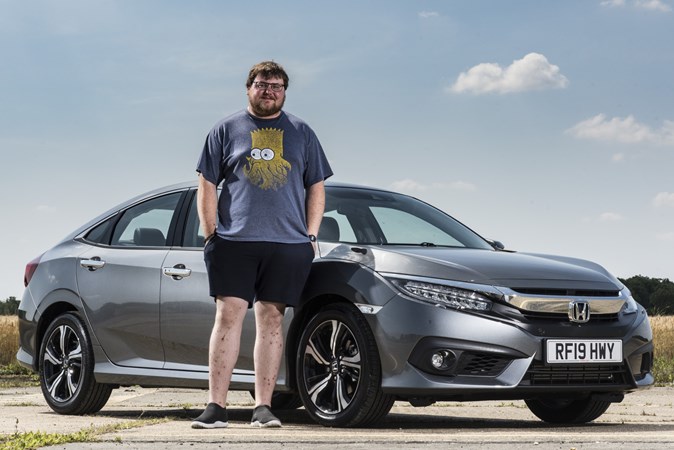
There was a time when family saloon cars were the norm, but nowadays you’re far more likely to find the driveways of suburbia filled with compact hatchbacks, executive saloons made achievable by generous finance packages and, of course, scores of SUVs and crossovers.
Honda still reckons there’s a place for the humble saloon in the UK market though, so it’s bought the humble Civic Four-Door (that’s a saloon to you and me, or a sedan in the States) to sit alongside its hipper hatchback sibling in Honda’s range. In a way, it’s also filling a gap left when the Accord was removed from sale.
Rivals? Of the non-premium brands there’s barely any. The Mazda 3 Fastback is worth considering, though the changeover to the latest model year means you’ll likely be buying something that’s sat on the forecourts for a while if you buy one now. There’s also the new Toyota Corolla saloon. The Skoda Octavia occupies the same area, despite being a hatchback, but the Civic’s real task will be convincing buyers that they don’t need an Audi A3 Saloon or Mercedes-Benz CLA.
What’s different?
The Civic saloon is more a tweaked version of the hatch than a standalone model. The two cars are near enough identical from the front doors forwards – though the saloon has a few extra chrome highlights. From the rear doors back, though, there’s a subtle reshaping, with a different roofline and flatter rear deck to make room for the boot opening.
Your choice within the range is slightly different, too. Saloon models aren’t offered with the high-powered 1.5-litre petrol that hatchbacks get – instead, there’s a choice of 129hp 1.0-litre three-cylinder petrol or 120hp 1.6-litre four-cylinder diesel.
Both are available with a brilliant six-speed manual gearbox, or as automatics. Petrol models are paired to a continuously variable transmission, while diesels get a nine-speed traditional automatic.
We’ve got a petrol, manual model, which is ideal. I’m not the biggest fan of Honda’s diesel engine, and the Civic’s manual gearbox is so fantastic to use that I’d never opt for anything else.
Monochrome is the order of the grey
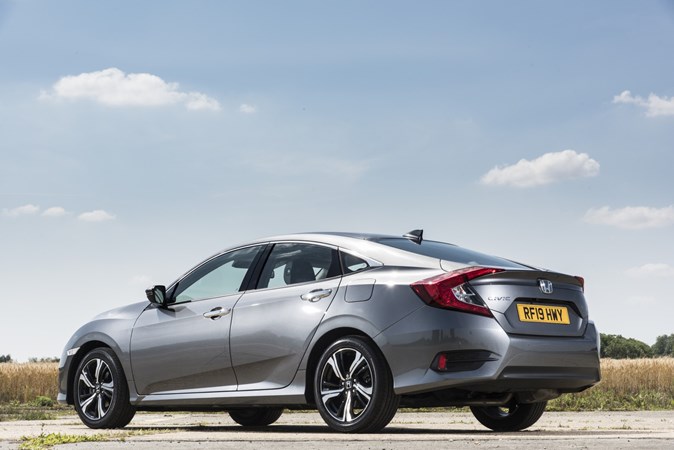
Shame, isn’t it? The Civic four-door has just five shades to pick from, but ours is in possibly the most boring of the lot – Polished Metal Metallic. That’s grey, or silver if you’re generous – and it’s a £525 cost option. Were it our money, we would have opted for the optional Brilliant Sporty Blue or even the standard, no-cost Rallye Red – both show off the styling better.
Regardless of your exterior colour choice there’s only one shade on the interior – black on black on black. With the odd bit of silver. This is a particularly monochrome place to be. Of course, that criticism can be made of most small German saloons too, so it’s not too much of a knock on the Civic.
What’s the spec like?
Generous. Honda’s sent us a top-of-the-range EX model, and there’s quite a lot to be pleased about. I’m personally thrilled to find LED headlights and a premium sound system, and I’m also chuffed that my enormous smartphone fits neatly on the wireless charging pad in the centre console.
EX trim brings the luxury of leather upholstery, keyless start and all-round heated leather seats over the lower-grade SR, too.
There are the usual suspects, too – dual-zone climate control, radar-guided cruise control and a 7-inch touchscreen infotainment system. When I’ve previously used this system, I’ve found it one of the worst on the market, but I’ll be interested to see whether an extended test allows me to get used to the quirks of Honda’s system.
And the price?
£25,135 all in. It’s to Honda’s credit that short of the paint, there’s not a single optional extra – and very few to select, either. If you’re really angling for it, Honda dealers will slap on silly items such as sill plates or rubbing strips if you ask them to, but both trims come well-enough equipped that you shouldn’t be desperate for too much more kit.
Why shouldn’t I just get a hatchback?
That’s a tricky question and one I’m going to try and figure out the answer to over my time with the Civic saloon. I like the hatch a great deal – and though the saloon offers a little more overall volume it’s undeniably less practical than its sibling. I’m moving house very soon, so I’ll be interested to see whether the Civic Four-door can handle the stress and strain of my possessions.
Until I move, though, it will be plying the A roads of Northamptonshire and Cambridgeshire on my 60 mile commute each day. It’ll be good at that.
Economy this month: 47.5mpg
Update 2: Practicality
Civic Saloon doesn’t make the best van
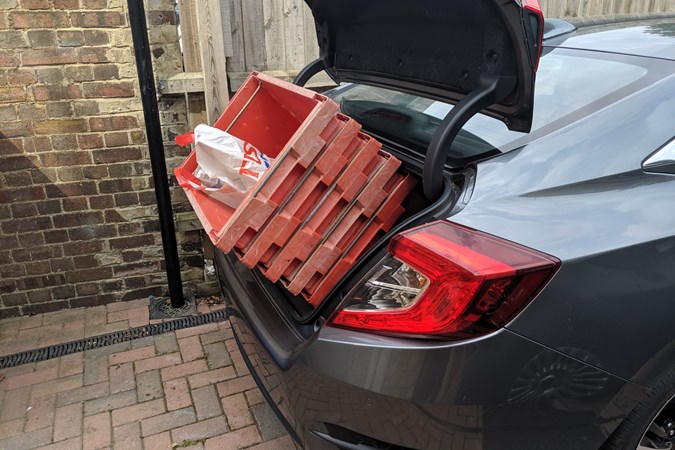
My Civic saloon is great at eating up motorway miles, but it’s definitely not the first car I’d choose for a house move. Nor did it have to be – thankfully, a Peugeot Boxer van took care of most of the heavy lifting. But once items such as sofas and mattresses and dining tables are out of the way, there remain the smaller items – the awkward ones – the lamps, boxes of books, fragile heirlooms and delicate electronics.
Transporting many of these from my storage unit in Cheltenham to my new flat near Peterborough fell to the Civic, and it was approximately 20 seconds into loading up that I began to curse whoever had specified ‘my’ car as a saloon, rather than a hatchback.
Narrow load opening
The biggest problem with the Civic saloon – or Sally the Ceviche, as I’ve christened her – isn’t the overall volume of the boot. In fact, that’s very good indeed, and for trips to the supermarket or for carrying small items it’s proven useful. It’s not as though I have a lot to put in there on a day-to-day basis, either. Apart from the occasional trip to collect a spur-of-the-moment internet purchase, it generally only ever has my backpack in.
The problem comes when folding the rear seats down to load longer or bulkier items. In a hatchback, this leaves a fairly cavernous space that can be filled to the brim. In the Civic? It leaves two separate load areas – the boot and the car’s interior – with a narrow, sharp-edged slot the only route between them.
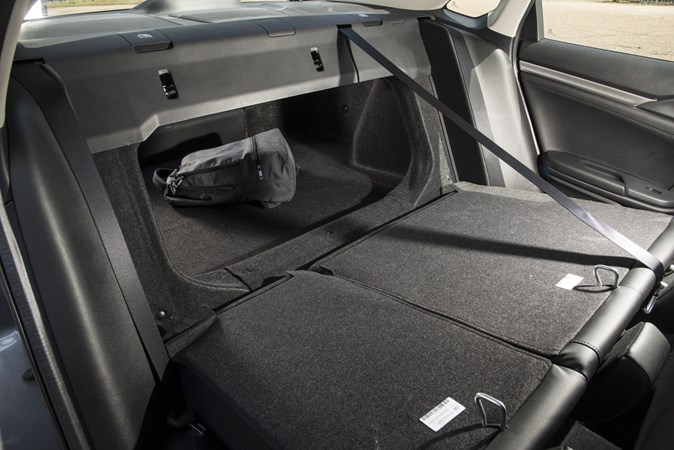
Now, admittedly, this is a criticism that can be laid at any saloon car, but it’s a valid one – and it’s a major reason why hatchbacks and SUVs now reign supreme among family buyers. A family car has to be everything from a limousine to a pickup truck, and the Civic saloon fails on the latter due to its inability to handle long, awkward and bulky loads.
I eventually resorted to loading my large boxes of books onto the folded back seats through the rear doors, and stuffed the awkward recesses of the boot with loose items that I hoped wouldn’t get broken in transit.
Plenty of space for passengers
With the moving of possessions complete, it’s on to moving passengers – thankfully, something the Civic saloon is pretty good at. A 250-mile slog with two passengers gave me my first opportunity to get a second opinion on the Civic’s passenger space and ride comfort.
The back seats have exceptional legroom and more than adequate headroom – a tall adult can really stretch out back here, impressive for what’s still essentially a Volkswagen Golf rival. There’s a modest transmission tunnel – that’s the ridge underneath the middle seat – and combined with the lumps and bumps of the fold-down centre armrest mean that this isn’t best suited to carrying three adults for anything other than short trips.
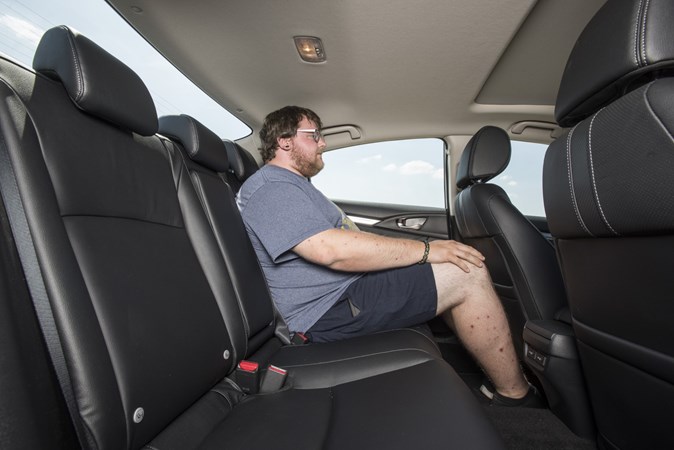
The footwells are large, so passengers don’t have to sit bolt-upright or knock-kneed, and our top-spec EX model even has heated rear seats for extra comfort.
Driver isn’t left out
Of course, the driving seat is just as comfortable as those further rearward – and though it’s a little light on under-thigh support for my liking, the low-set driving position is very relaxing for me.
There’s also plenty of storage, with big door bins and a cavernous centre cubby. I also like that my USB cable – necessary to run Android Auto on the car’s infotainment system – can be hidden behind the centre console.
So the Civic saloon is superbly practical for people – but it’s when awkwardly shaped baggage is thrown into the mix that it starts to crumble. I still can’t really think of a reason why you’d buy the Civic saloon over the hatchback – the latter may have a slightly smaller load area in terms of overall volume, but it’s vastly more versatile and practical.
Economy this month: 48.9mpg
Update 3: Interior
Straight-laced cabin is easy to use
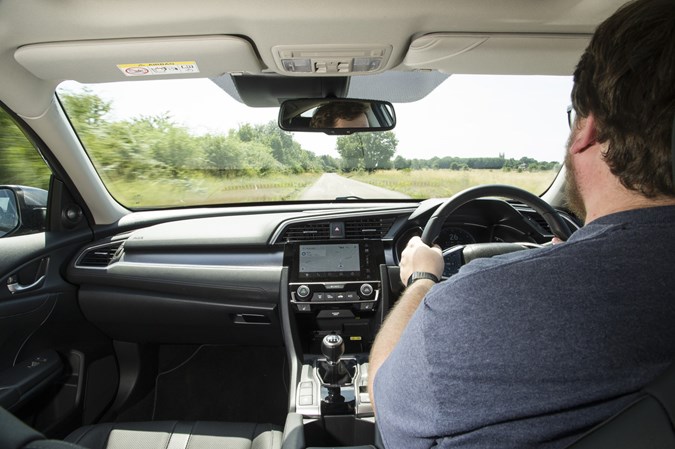
The Civic’s saloon’s exterior looks are divisive. But honestly, that doesn’t bother me – after all, I spend most of my time inside the car, as most drivers tend to do. If you can drive your car while sitting outside it, you may actually be on a horse.
That means that some of the most important aspects of a car to me – after how it drives – is how the interior feels, how it’s screwed together, what equipment it has to offer and, most importantly, what it’s like to live with day-to-day.
Thankfully, despite the oddball exterior styling, the Civic’s interior is more conventional – and rather good.
Simple is sometimes best
My favourite thing about the Civic’s interior is how well it nails the basics. The driving position, for example – it’s nice and low-slung, with plenty of adjustment in the seat and steering wheel. I’ve got pretty long legs, but even I don’t have to have the seat in its rearmost position – a rarity, even on large cars.
The gear lever sits in the high-set centre console, and it’s nice and stubby so shifting isn’t a big stretch. Ideal for those more spirited drives.
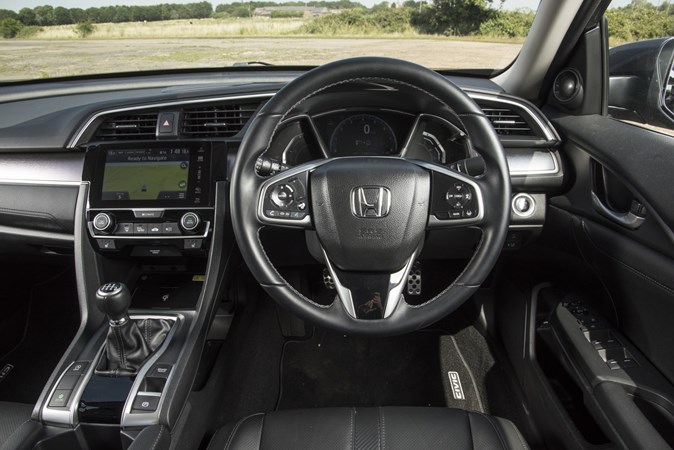
Another area where simplicity wins out is in the instrument cluster. It’s a digital model, with a screen instead of physical dials, and while some examples of these can be a little clustered and difficult to read Honda has traded out configurability for legibility here. Instead of a variety of viewing options, Honda sticks to a simple digital speedometer and half-moon rev counter, with various driving information visible underneath. It’s clear and easy, and some rivals could learn a lesson here.
Honda is also the only manufacturer that I know of that uses Android Auto to display navigation data in the instrument cluster as well as on the infotainment display. It’s a small touch, but one that really helps the phone feel an integral part of the experience.
Small details annoy
As ever, it’s the little niggles that get on your nerves day-to-day. Some of mine are particularly petty, such as the area of squeaky trim on the centre console that I’ve not observed on any Brit-built Civic hatch (the Civic saloon is built in Turkey) or the unresponsive touch-sensitive buttons to the side of the infotainment display.
I’m also baffled by the cupholder arrangement. Civics sold in the US have a clever sliding dual cupholder in the centre console, but UK models get just one deep example. It can be split into two, but once the second cupholder has been liberated there doesn’t seem anywhere stable to put it. It’s thoroughly confusing.
Sub-par infotainment
As I mentioned, I nearly always plug my phone – a Google Pixel – into Android Auto on the Civic’s relatively small (but bright and responsive) 7.0-inch touchscreen. When it’s running that software, it’s great. When it’s running its own… well, things aren’t quite so good.
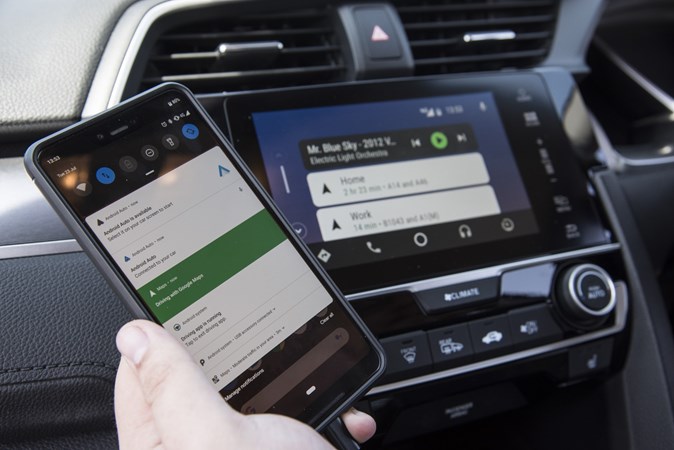
Honda’s infotainment system remains one of the most irritating on the roads, with seemingly basic functions hidden behind a myriad of menu screens. I spent a solid ten minutes attempting to find the equaliser before giving up in a huff – if anybody knows, answers on a postcard please.
This is especially surprising as Honda’s infotainment runs on Android – the same simple-to-use and powerful operating system as my beloved phone. Fingers crossed that the easy-to-update nature of a mobile OS means that future Hondas will see big improvements in their infotainment.
Economy this month: 48.1mpg
Update 4: Engine and handling
Small niggles don’t detract from positive experience
More than 6,000 miles into our stewardship of Sally the Ceviche seems like plenty of time to collect my thoughts on her (really rather good) powertrain.
As I’ve mentioned already, my Civic’s equipped with a 1.0-litre turbocharged engine and six-speed manual gearbox. Now, this is nothing like Honda’s legendary performance engines such as the 2.0-litre K20A you’ll find in Content Manager Lawrence Cheung’s EP3 Civic Type R. It won’t rev to 9,000rpm, there’s no sudden boost as you reach VTEC and, disappointingly, performance is actually rather sedate.
Instead, it’s a pragmatic choice that’s surprised me with how fit-for-purpose it is.
Downsizing? What downsizing?
There are plenty of big cars with puny engines around at the moment – downsizing is the fashion, after all, and it’s not limited to superminis. You’ll find a 1.0-litre engine in base models of the massive Skoda Octavia, a 1.2-litre in the seven-seat Peugeot 5008, and a 1.3-litre perched in the Renault Grand Scenic.
The Civic’s engine is actually one of the most powerful 1.0-litre units around, producing 129hp with the aid of a turbocharger. That’s second only to Ford’s 140hp EcoBoost engine, fitted in the Fiesta and Focus.
It’s a cliché, but it drives like it has a much larger engine. Passengers have commented as much, and it feels suitably meaty under the pedal. In fact, though it’s far from a direct comparison, I was interested to find that the other grey saloon in my life – my beloved Peugeot 605 – is comparable on power, with 130hp, but uses a 2.0-litre engine. That’s what 25 years of progress gets you…
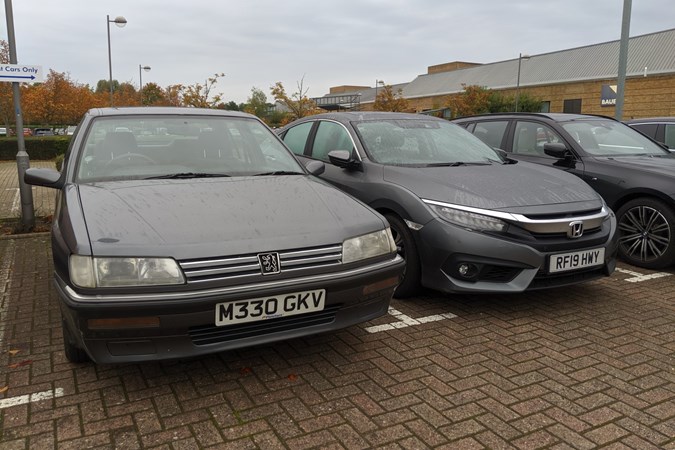
It’s only breathlessness at low revs that betrays the Civic’s humble capacity, but once you get going it’s a pleasure to use.
But not as much of a pleasure as the gearbox. I reckon that of the mainstream brands, Mazda makes the best manual gearboxes, but Honda runs it a close second. The six-speed stick in my Civic is a delight to snick between gears, with a short throw, comfortably stubby gearlever and a perfect position high up on the centre console.
I also find the ratios really well-judged, which you might be surprised to know isn’t necessarily a given. A recent weekend in a Kia Ceed had me cursing whoever decided 30mph should be too high a speed for third gear but too low for fourth. The Civic’s are ideally spaced, and sixth is nice and high to make long-distance cruising a pleasure.
Impressive economy on test
The car itself claims it’s doing 49mpg, and by my calculations that’s pretty well on the nose. That’s a really good figure for what’s really quite a large car, and it’s actually more than the car’s WLTP figure of 47.1mpg. It’s no doubt aided by my journeys, which tend to be prolonged runs on fast A-roads and motorways – but it does also include my commute, which is a rash of stop-start traffic, acceleration between roundabouts and, certainly in winter, slow work on flooded roads.
These journeys have all shown off the Civic’s highly accomplished chassis in its best light, too. I’ve mentioned before how comfortable this car is, but the handling is equally impressive. It’s not overtly sporty but, like the gearshift, it’s beautifully balanced and well-judged. This is a wonderful car to carry just a little more speed in than you normally would – the weighty steering, excellent grip and composed body all encourage it. No, you’re not going to be nailing it like you would this car’s amazing Type R brother, but there’s no need.

Nothing’s perfect, though, and the Civic does have a few foibles. First, there’s the noise. It doesn’t bother me, but there’s no denying it does make a bit of a racket if you’re pressing on. It’s characteristic of these three-cylinder engines, but Ford’s EcoBoost or Peugeot’s PureTech units are more hushed.
More annoyingly, the engine’s flywheel has quite an effect on it. What I mean by that is that it’s not the most responsive to changes in throttle. Let off the gas, and the engine’s revs hang for ages before they recede. This means that when changing gear, I end up using the clutch to pull the engine down to the right revs, instead of slotting it in as the rpm dies down naturally.
It sounds small, but it makes it more difficult than it should be to drive the car smoothly – especially when I’m in a hurry.
Overall, though, I think the Civic’s powertrain is one of its most impressive aspects, particularly that wonderful gearbox. As we draw closer to the end of our time with the car, I’m sure it’s what I’ll miss the most.
Economy this month: 49.0mpg
Update 5: Rivals
Why would you buy a Honda Civic Saloon?
My reports on the Civic so far have been mixed, I’d say, but with a generally positive flavour. I do genuinely like this car, though I struggle to get excited by it.
However, what I’m really struggling to figure out is who would buy a Civic saloon. My car costs just over £25,000, and though that might not seem like a huge sum, it’s a difficult spot to occupy. Some hugely talented opposition can be had at that price point.
Nowhere is this more apparent than on Honda’s own configurator. I specced up a Civic Hatch to Sport trim, which concedes only leather upholstery, heated seats and a sunroof to my Saloon’s EX. It comes in at a mere £23,775 painted in the same metallic hue. BUT (and it’s a big but), that’s with the 1.5-litre four-cylinder engine, which offers more than 50hp more than my car’s 1.0-litre three-cylinder.

Look elsewhere and the Civic becomes even harder to rationalise. You could have a Mazda 3 Saloon, either in Spartan Sport trim but with the clever SkyActiv-X engine, or in more luxurious Sport Lux with the basic engine. Both are as good as or even better to drive than the Civic but, in my opinion, look far better and offer a vastly superior interior and again, they don’t lack much in terms of equipment.
A Toyota Corolla saloon is somewhat of a left-field choice, but the clever hybrid powertrain essentially rivals the Civic Saloon’s automatic variant, which slips in just above £26,000. For that, top-spec Design models become available, which includes all the equipment of the Civic, but the added benefit of 83g/km of CO2 emissions and remarkable fuel economy, not to mention a five-year warranty to the Honda’s three.
If it’s equipment you’re after, the Kia Ceed is hard to ignore. It’s not a saloon, no, but for over £2,000 less than the Civic you can have a huge 10.25-inch infotainment screen, heated front seats and steering wheel, a stylish GT-Line body kit and the pleasant if not spectacular 1.4-litre petrol engine. Oh, and a seven-year warranty, beating even Toyota on this front.
Czech mate
For me, though, the biggest competition comes from the Czechs. A Skoda Octavia SportLine is bigger, more practical and more powerful with its 150hp engine and again, it only lacks heated seats, a sunroof and leather upholstery. In fact, you could even argue that the extremely comfortable sports seats are in fact an upgrade from the Civic.
I’ve been impressed with my Civic’s economy, but a weekend with the Octavia Sportline saw its 150hp 1.5-litre engine return over 50mpg with consummate ease. And while design is subjective, I think the Octavia’s clean lines and sharp detailing is more pleasing to the eye than the Honda’s rather messy chrome highlights.
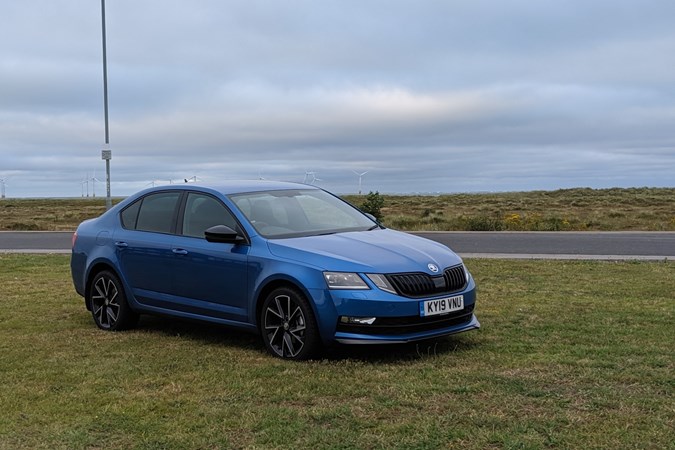
Most compellingly of all, the Octavia’s more than £60 a month cheaper on a PCP deal over the same term with the same deposit. A new Octavia is on the way early next year, too – so you may be able to secure big discounts on the outgoing car, which is still a staggeringly good vehicle.
I’d say that’s a very good reason to opt for the Skoda and, sadly, a reason why the otherwise rather good Civic Saloon probably isn’t a particularly good buy unless you can secure a big discount or your local Honda dealer is good enough to be worth paying for.
Economy this month: 48.3mpg
Update 6: Goodbye

As I write this, I’ve just got back from the launch of the facelifted Civic Hatchback – where Honda’s informed me that it’s sold nearly all its stock of Civic Saloons and it won’t be bringing the updated model into the country.
In effect, then, my long-termer’s been made obsolete the day before it’s due to be collected by Honda. But it does allow me to reflect on six months of ‘ownership’ without any worries that what I’m saying might be harming future sales… And since my most pervading feeling from our long-term test has been that the Saloon is a largely pointless addition to the range, that’s probably a good thing.
But the Hatch soldiers on, which allows me to give a cast-iron recommendation: buy it. The Saloon’s positive features – the excellent engine, the great driving manners and the straightforward cockpit to name a few – are all common to both cars.
In fact, I think the Civic platform’s something of a hidden gem, and one that deserves to sell far better than it does. It strikes that elusive near-perfect balance between handling and ride comfort – making for a car that’s both easy to drive but enjoyable to press-on with.
Some competitors are more comfortable and some others are more engaging, but I really do put the Civic up there on the podium with the Mazda 3 and Ford Focus in terms of overall driving experience.
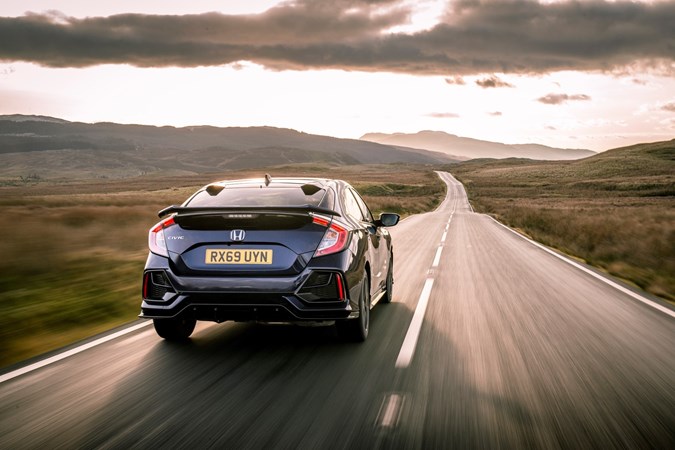
Better yet, my biggest complaint with the Saloon – namely, the total lack of any flexibility in the boot – is not even a bit of a problem when it comes to the Hatch. With a large tailgate, huge boot, flat-folding rear seats, it’s immensely practical. I also love the load cover, which is somewhat like a little roller blind and folds up to a package not much larger than an umbrella. Much easier than having to find room for a huge sheet of particleboard.
Other complaints I’ve had – such as the lack of physical controls for the infotainment – have been addressed in the facelifted model, boosting its case even further.
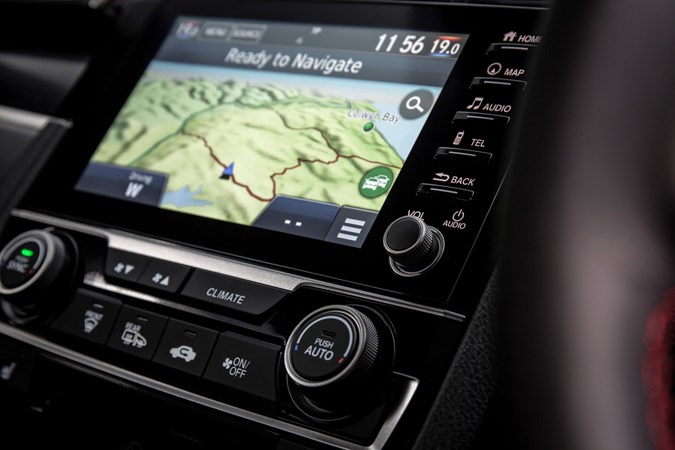
I’m also going to give a particular shoutout to the Civic’s suite of advanced safety aids. Somewhat cringily named ‘SENSING’, I found the combination of adaptive cruise control and lane-keeping assist to work almost seamlessly. In fact, I used it almost every time I drove the car – high praise, considering the majority of these systems find themselves instantly switched off.
During our six months and 8,000 miles with the Saloon, my opinion on the car didn’t change a great deal. I came into the term already liking the Civic platform, and I left it in the same way. Sally the Ceviche, as she soon became christened, was painless to own – visiting the dealer only once to adjust the aim of the LED headlights. She was fuel-efficient, cossetting on some of my longer drives up and down the country and made for a reliable commuting machine.
As for running costs, I was thrilled to average more than the WLTP fuel economy for most of our time with the car. In fact, every month my calculated fuel economy was over the 47.1mpg combined figure. I’ll put this down to covering mainly motorway miles in the car, with the cruise control at a constant 70mph.
So while I can’t claim to have fallen in love with our grey Civic Saloon, I’ll happily recommend the Hatchback she was based on as something well worth considering alongside huge volume-sellers such as the Ford Focus and VW Golf.
Economy this month: 48.1mpg
Overall fuel economy: 48.3mpg



.jpg)
.jpg)
.jpg)

.jpg)
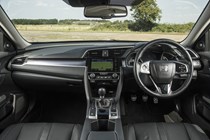

.jpg?quality=50)
.jpg?quality=50)
.jpg?quality=50)

.jpg?quality=50)
